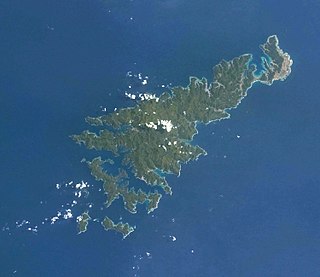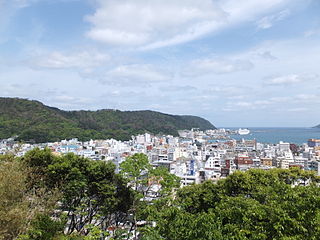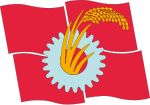
Amami Ōshima, also known as Amami, is the largest island in the Amami archipelago between Kyūshū and Okinawa. It is one of the Satsunan Islands.

The Amami language or languages, also known as Amami Ōshima or simply Ōshima, is a Ryukyuan language spoken in the Amami Islands south of Kyūshū. The southern variety of Setouchi township may be a distinct language more closely related to Okinawan than it is to northern Ōshima.

Amami is a city located on the island of Amami Ōshima, in Kagoshima Prefecture, Japan.

Toshio Shimao was a Japanese novelist. He has been called a "writer's writer", which is used as both a compliment and criticism.

The Ryukyu Islands, also known as the Nansei Islands or the Ryukyu Arc, are a chain of Japanese islands that stretch southwest from Kyushu to Taiwan: the Ōsumi, Tokara, Amami, Okinawa, and Sakishima Islands, with Yonaguni the westernmost. The larger are mostly high islands and the smaller mostly coral. The largest is Okinawa Island.

Amami Airport is an airport located 21.9 km (13.6 mi) east northeast Amami, a city on Amami Ōshima in the Kagoshima Prefecture of Japan.

Shomu Nobori was the pen-name of a noted translator and educator of Russian literature in Taishō and Shōwa period Japan. His real name was Naotaka Nobori. He also served as a special advisor to the Japanese cabinet on Russian and Soviet issues.

The invasion of Ryukyu by forces of the Japanese feudal domain of Satsuma took place from March to May 1609, and marked the beginning of the Ryukyu Kingdom's status as a vassal state under the Satsuma domain. The invasion force was met with stiff resistance from the Ryukyuan military on all but one island during the campaign. Ryukyu would remain a vassal state under Satsuma, alongside its already long-established tributary relationship with China, until it was formally annexed by Japan in 1879 as Okinawa Prefecture.
Shima-uta is a genre of songs originating from the Amami Islands, Kagoshima Prefecture of southwestern Japan. It became known nationwide in the 2000s with the success of young pop singers from Amami Ōshima such as Hajime Chitose and Atari Kōsuke.
Noboru Ogasawara was a Japanese physician (dermatologist) specializing in leprosy. He was an assistant professor at the Department of Kyoto Imperial University. He insisted that leprosy was not incurable and diathesis was an important factor in the development of leprosy. He was against strict segregation of leprosy patients and met strong opposition at a Congress of leprosy.
As Japanese citizens, people of the Amami Islands today only have family names and given names. They are known for many unique one-character surnames that date back to the Edo period. A survey on telephone directories of 2002 shows that 21.5% of the residents of the Amami Islands have one-character surnames. Famous people with one-character surnames include Atari (中) Kōsuke, Hajime (元) Chitose and Nobori (昇) Shomu.
The Kikai language is spoken on Kikai Island, Kagoshima Prefecture of southwestern Japan. It is debated whether it is a single dialect cluster. Regardless, all Kikai dialects are members of the Amami–Okinawan languages, which are part of the Japonic languages.

The 1965 Philippine Sea A-4 crash was a Broken Arrow incident in which a United States Navy Douglas A-4E Skyhawk attack aircraft of Attack Squadron 56 (VA-56) carrying a nuclear weapon fell into the sea off Japan from the aircraft carrier USS Ticonderoga. The aircraft, pilot and weapon were never recovered.

Kakeromajima (加計呂麻島) or Kakeroma-tō is one of the Satsunan Islands, classed with the Amami archipelago between Kyūshū and Okinawa.
Ryukyuan music, sometimes called Nanto music, is an umbrella term that encompasses diverse musical traditions of the Ryukyu Islands The term "Southern Islands" is preferred by Japanese scholars in this field. Unlike in the West, the Japanese notion of "Ryukyu" is associated with the former Ryukyu Kingdom based on Okinawa Island and its high culture practiced by the Yukatchu class in its capital of Shuri. By contrast, most scholars cover a much broader region and lay emphasis on folk culture.
The Tokunoshima language, also Toku-No-Shima, is a dialect cluster spoken on Tokunoshima, Kagoshima Prefecture of southwestern Japan. It is part of the Amami–Okinawan languages, which are part of the Japonic languages.
Tadashi Kanehisa was a Japanese folklorist and linguist who worked on the language and culture of his home island Kakeroma, and by extension, Amami Ōshima of southwestern Japan. As an informant of the Shodon dialect, he also worked with linguists Yukio Uemura, Shirō Hattori and Samuel E. Martin.
Minami Kizuki, born on 26 December 1989, is a Japanese pop and Shima-uta folk singer. She was born in Amami Ōshima, Kagoshima, Japan. In 2006, Kizuki was recruited by Pony Canyon while performing on Kagoshima City's streets. Her debut single, "Ai Tsumugi" was released on January 7, 2009.

Amami Guntō National Park is a national park in Kagoshima Prefecture, Japan. Established in 2017, the park comprises a land area of 42,181 ha and a sea area of 33,082 ha. The national park includes areas of these islands: Tokunoshima, Kikai, Amami, Yoron, Okinoerabujima, Uke Island, Kakeromajima and Yoroshima.












